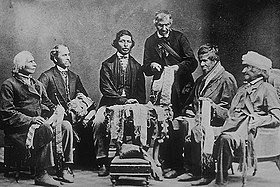
John Buck (c. 1818 – 1893), titled Skanawati among other variants, was a leader of the Onondaga who lived near Ontario's Grand River. He was the official keeper of the wampum records of the Iroquois, sometimes described as a firekeeper. He took on the role of wampum keeper in 1843. Buck was described in a contemporary account as "a capable ruler and an able and trustworthy negotiator". Kenyon and Kenyon identify him as a "follower of Handsome Lake".
Background

John Buck was born c. 1818. He was described in an obituary as being descended from "ancient Iroquois nobility" and was of Tutelo descent.
Role as cultural keeper
Buck assumed the role of wampum keeper in 1843. As the official keeper of the wampum records of the Haudenosaunee, he was described as being a "conservative" leader who closely followed the traditional customs of his people. Although Buck did not speak the language, he gave lengthy interviews with English-speaking historians in an effort to preserve Haudenosaunee culture. Scholars such as J. N. B. Hewitt drew on Buck's knowledge of his people's history.
Political advocacy
In June 1887, Buck and several other members of the Iroquois petitioned the Canadian government to repeal portions of the Franchise Act, which had offered tribes including the Onondaga the right to vote.
Work with anthropologists
He was friends with Horatio Hale. Frank Speck purchased Buck's ritual mask collection.
Death and legacy
He died in 1893, aged approximately 75. Buck's children sold wampum belts that he had held.
Notes
- Variant transliterations include Sha-na-wa-de and Shanawati. A contemporary source translated Ska-na-wa-ti as meaning "beyond the swamp" and said that the name had been in his family for several generations.
- Kenyon and Kenyon estimate Buck's birth as between 1823 and 1826, suggesting that he was younger than 75 in 1893.
- ^ "A Famous Indian". Buffalo Morning Express and Illustrated Buffalo Express. 1893-04-02. p. 3. Retrieved 2021-02-07 – via Newspapers.com [REDACTED] .
- ^ Buffalo Historical Society 1885, p. 12.
- ^ Buffalo Historical Society 1885, p. 46.
- ^ Welles 1892, p. 17.
- ^ Hale 1883, p. 41.
- ^ Rogers & Smith 1994, p. 192.
- ^ Muller 2007, p. 137.
- Hale 1883, p. 161.
- ^ Kenyon, Ian; Kenyon, Thomas (February 1986). "Echo the Firekeeper: A Nineteenth Century Iroquois Site" (PDF). KEWA: Newsletter of the London Chapter, Ontario Archaeological Society. 86 (2): 12. ISSN 0228-4111.
- Fenton, William Nelson (1998). The Great Law and the Longhouse: A Political History of the Iroquois Confederacy. University of Oklahoma Press. p. 74. ISBN 978-0-8061-3003-3.
- Little, J. I. (2018-11-16). "Courting the First Nations Vote: Ontario's Grand River Reserve and the Electoral Franchise Act of 1885". Journal of Canadian Studies/Revue d'études canadiennes. 52 (2): 538–569. doi:10.3138/jcs.2017-0071.r1. ISSN 1911-0251. S2CID 149763260.
- Wonderley, Anthony Wayne; Sempowski, Martha Lou (4 December 2019). Origins of the Iroquois League (First ed.). Syracuse, New York: Syracuse University Press. ISBN 978-0-8156-5492-6. OCLC 1124793257.
- Bruchac, Margaret M.; Zobel, Melissa Fawcett Tantaquidgeon (2018-04-10). Savage Kin: Indigenous Informants and American Anthropologists. University of Arizona Press. p. 163. ISBN 978-0-8165-3706-8.
- Muller 2007, p. 140.
- Tooker 1998, p. 223.
- Rogers & Smith 1994, p. 196.
- "Chief John Buck: The Leader of the Six Nations Dies at His Home in Ontario". New-York Tribune. 23 March 1893. ProQuest 573780042.
- Hamilton, Michelle A. (2008). "Borders Within: Anthropology and the Six Nations of the Grand River". In Hele, Karl S. (ed.). Lines drawn upon the water First Nations and the Great Lakes borders and borderlands. Waterloo, ON: Wilfrid Laurier University Press. p. 196. ISBN 978-1-55458-004-0. OCLC 163617254.
Sources
- Hale, Horatio, ed. (1883). The Iroquois Book of Rites. Library of Aboriginal American Literature. Vol. 2. Philadelphia: Daniel Garrison Brinton. OCLC 1048299478.
 This article incorporates text from this source, which is in the public domain.
This article incorporates text from this source, which is in the public domain. - Muller, Kathryn V. (2007). "The Two "Mystery" Belts of Grand River: A Biography of the Two Row Wampum and the Friendship Belt". American Indian Quarterly. 31 (1): 129–164. doi:10.1353/aiq.2007.0013. ISSN 0095-182X. JSTOR 4138898. S2CID 162334379.
- Obsequies of Red Jacket at Buffalo, October 9th, 1884. Transactions of the Buffalo Historical Society. Vol. 3. Buffalo: Buffalo Historical Society. 1885. OCLC 297246323.
 This article incorporates text from this source, which is in the public domain.
This article incorporates text from this source, which is in the public domain. - Rogers, Edward S.; Smith, Donald B. (1994). Aboriginal Ontario: Historical Perspectives on the First Nations. Dundurn Press. ISBN 978-1-55488-063-8. OCLC 244771106.
- Tooker, Elisabeth (1998). "A Note on the Return of Eleven Wampum Belts to the Six Nations Iroquois Confederacy on Grand River, Canada". Ethnohistory. 45 (2): 219–236. doi:10.2307/483059. JSTOR 483059.
- Welles, S. R., ed. (1892). Unveiling of the Monument Erected by the Waterloo Library and Historical Society, as a Memorial of Red Jacket. Waterloo, New York: Waterloo Library and Historical Society. OCLC 1158057471.
 This article incorporates text from this source, which is in the public domain.
This article incorporates text from this source, which is in the public domain.
Further reading
- Buck, John (1928) . "What Is Wampum?". 36th Annual Archæological Report. Toronto: King's Printer for Ontario. pp. 48–50. OCLC 1039497427.
- Hale, Horatio (May 1895). "An Iroquois Condoling Council". Proceedings and Transactions of the Royal Society of Canada. 2nd series. 1: 45–65. ISSN 0316-4616.
External links
- [REDACTED] Media related to John Buck (Onondaga politician) at Wikimedia Commons
- Tutelo war club owned by Chief John Buck, National Museum of the American Indian